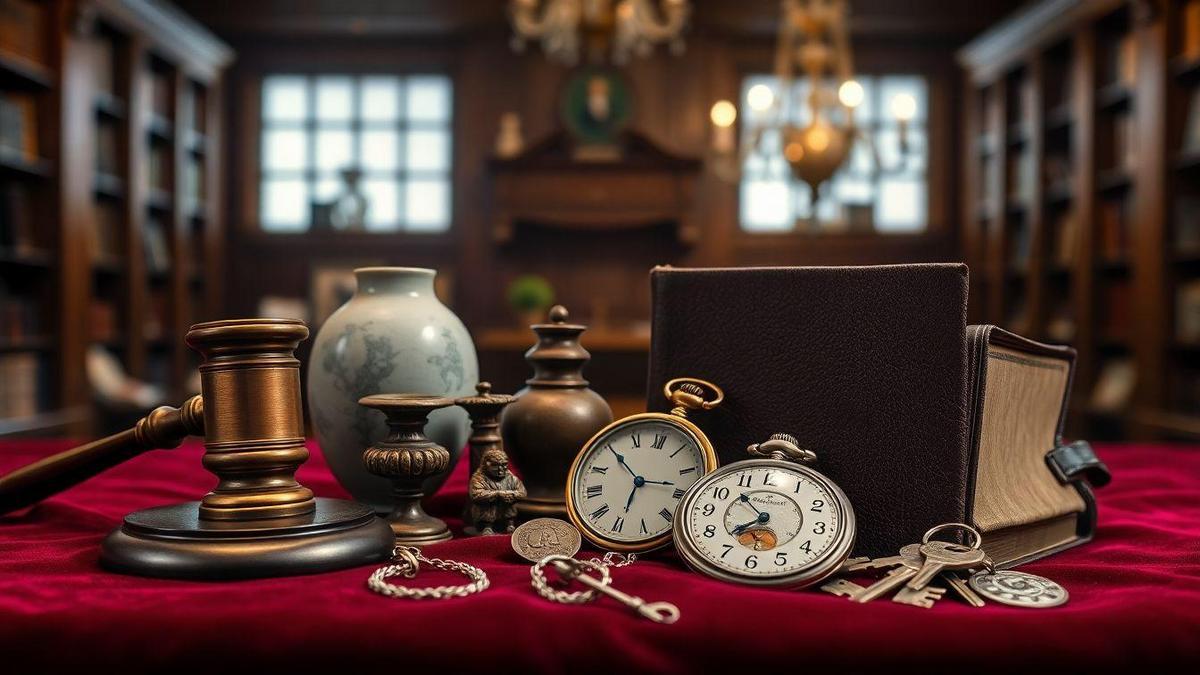How you bid at an Art, collectibles, and antiques auction in the United States
You can bid confidently if you learn a few steps first. Treat each auction like a short test: study the lot, set a plan, and act at the right moment.
Auctions move fast; if you come unprepared you risk overpaying or losing items you wanted.
This guide focuses on bidding at an Art, collectibles, and antiques auction and walks you through channels, registration, fees, and tactics to win without blowing your budget.

Live room, phone, and online bidding (LiveAuctioneers, Invaluable, etc.)
There are three main bidding channels, each with its own rhythm:
- Live room: Raise your paddle and compete in person. You read the room and react to pace and body language. Major houses (Sotheby’s, Christie’s) and regional houses (Freeman’s, Doyle) run live sales.Phone: Request a phone line before the sale. An agent bids for you in real time—best for high-ticket lots when a human voice matters. Register early; lines fill fast.
- Online: Platforms such as LiveAuctioneers, Invaluable, Bidsquare, and AuctionZip stream auctions and run timed sales. Register on the platform and for each sale. Online bidding is often the most convenient for buyers nationwide.
Absentee (proxy) bids let the house bid up to your max before or during the sale. Pick the channel that fits the lot—heavy furniture often benefits from being local; prints, small paintings, and jewelry generally work well online.
How to register, set a budget, and understand buyer’s premiums
Register before bidding—houses typically require ID and a credit card; high-value lots may need wire pre-approval or bank references. Set a firm top number that includes:
- Hammer priceBuyer’s premium (typically 15–25% in the U.S.; some houses use tiered rates)Sales tax (depends on seller and shipping destination)
- Shipping and insurance (add 10–20% as a rough buffer for large items)
Read invoice terms—online platforms may add platform fees. For big purchases expect deposits and pre-approval. Stick to your maximum: fees can push a seemingly affordable hammer price beyond reason.
How to place a winning bid
- Live room: raise your paddle clearly, make eye contact, and confirm loudly if needed.Phone: speak slowly, confirm lot and amount, ask the agent to repeat.
- Online: click once—don’t double-click—and use the platform’s live stream. For absentee bids, submit a clear maximum; the house will bid up to it using normal increments.
Watch the auctioneer’s pace. If an item matters, consider a jump above the normal increment to discourage test bids. Use proxy bidding to avoid paying your maximum unless necessary. If bidding many lots, focus on the ones where you can add value later.
Where you can find Art, collectibles, and antiques auction listings across the United States
Auctions run everywhere—from major-city marquee sales to small-town estate dispersals. Search calendars and platforms to spot sales that fit your interests in an Art, collectibles, and antiques auction market.
Major auction houses and online platforms (Sotheby’s, Christie’s, Heritage, eBay)
- Sotheby’s and Christie’s handle high-end global sales (fine art, design, jewelry).Heritage Auctions (Dallas) leads in collectibles: comics, coins, sports memorabilia.Bonhams, Phillips, and regional houses (Freeman’s, Skinner, Hindman, Doyle) specialize by category and location.
- LiveAuctioneers, Invaluable, Bidsquare, and AuctionZip connect you to hundreds of houses; eBay remains useful for timed listings in lower- to mid-value ranges.
Check house calendars and set alerts for artists, makers, or categories you follow.
Local estate sales, antiques, and museum deaccession sales
- Estate sales and local auctions (listed on EstateSales.net and AuctionZip) are good sources for furniture, collections, and overlooked items.Museum deaccessions are rarer but can surface well-documented lots with strong provenance.
- Small museums and historical societies sometimes sell parts of collections—these often fly under the radar.
Use trade shows and fairs for targeted auctions of design pieces or single-owner collections.
Sites and calendars to discover hidden treasures
Use LiveAuctioneers and Invaluable for live streams and timed sales; AuctionZip for local schedules; eBay and house archives for price history. Sign up for newsletters, follow departments on social media, and monitor museum press rooms for deaccession notices.
How fine art appraisal and valuation help you avoid bad buys at auction
Appraisals and condition checks reduce risk and help you set realistic bids at an Art, collectibles, and antiques auction.
When to get a professional appraisal
- Consider an appraisal if a lot could exceed $1,000; get a detailed written appraisal for lots above $5,000.For five-figure pieces, hire a specialist appraiser with auction experience.Get appraisals when authenticity, provenance, or restoration is in doubt, or when you need insurance or collateral documentation.
- If bidding remotely, commission a condition report or independent examination if the house’s report is vague.
Provenance, condition, and market comparables
- Provenance: look for receipts, exhibition history, or published mentions—strong provenance raises trust and price.Condition: read condition reports carefully; major restoration can substantially reduce value.
- Comparables: use recent sales of similar items to set a price band. Balance comps across house tiers and sale contexts for a realistic estimate.
How appraisals affect price and insurance
Written appraisals help with insurance claims, set bidding limits, and support tax reporting for donations or dispositions. Appraisers charge flat fees, hourly rates, or sometimes percentage fees—ask up front.
How you can spot rare art and antiques at auction and make smart investments
Rarity, provenance, maker marks, and market timing all matter when buying at an Art, collectibles, and antiques auction.
Signs of rarity: maker marks, signatures, and verified provenance
- Check maker marks, signatures, labels, and collection stickers.Certificates of authenticity, lab reports, exhibition history, and publications add premium value.
- Use ultraviolet light and magnification to inspect paint layers, stamps, and hidden signatures.
Simple steps for collectible art investment and resale planning
- Set goals: enjoyment, resale, or both.Study price history for the artist or category over 3–5 years.Diversify across categories and price bands.Set a multi-year horizon (typically 3–10 years) and plan for holding costs: insurance, storage, conservation.
- Plan your exit: consignment, house sale, or online resale—factor in seller fees and timelines.
Red flags to avoid
- Thin or missing provenanceInconsistent wear or signs of forgeryOver-restoration or poor documentation of repairsPhotos that hide damage; always request close-ups or in-person inspection
- Conflicting authentication sources—seek clarity before bidding
How to consign your items to auction houses for antiques and collectibles in the United States
Selling at auction can reach many buyers and generate competitive bids when the market is active.
How auction house consignments work and typical seller fees
- Submit photos and details; the house recommends estimates and a sale date. Sign a consignment agreement with reserves, fees, and terms.Reserves set the lowest acceptable price; they can affect fee structure.Seller commissions usually run 10–25% of hammer price; expect handling, photography, catalog, and storage fees.
- Payment typically occurs 30–90 days after the sale, subject to buyer payment clearing and any returns.
Choosing the right house for your items
- Match specialization to your category (design houses for mid-century, Heritage for coins/comics).Compare fees and marketing reach—higher fees can mean better promotion and higher final prices.Review past catalogs and sold prices; negotiate terms for high-value consignments.
- For speed, use online-only houses; for a marquee sale, choose a major house with longer lead time.
Steps to prepare, photograph, and describe items
- Clean gently; avoid major DIY repairs.Photograph in natural light with clear backgrounds and multiple angles; include maker marks and damage.Provide honest descriptions with maker, dimensions, date, condition, provenance, and weight for shipping.
- Keep documentation (receipts, catalogs, appraisals) and set a realistic reserve based on comparables.
How to handle shipping, insurance, and care after you win at an Art, collectibles, and antiques auction
After the hammer falls at an Art, collectibles, and antiques auction, protect your purchase through proper packing, shipping, insurance, and storage.
How auction houses handle packing, shipping, and local pickup
- Houses offer packing and shipping; high-value lots use professional art packers and crating.Large furniture and fine art travel via specialized movers—get written shipping estimates for costly moves.
- Pickup windows are limited; storage fees may apply after a grace period. Inspect items at pickup and photograph any new damage.
Insuring and storing valuable items
- Insure from the moment the hammer falls. Your homeowner’s policy may cover small items; schedule high-value pieces under a specialist policy.Provide the invoice and appraisals for proof of value.Store items in climate-controlled environments; use acid-free matting and UV-filtering glazing where appropriate.
- Update insurance as values change and review coverage annually.
Practical tips to protect your treasures during transit
- Photograph lots before shipping and keep images for claims.Insist on professional packing (crates, foam inserts) and insured shipping that covers hammer price plus buyer’s premium and shipping.Require signature on delivery or white-glove service for high-value items.Track shipments actively and inspect immediately on arrival; keep shipping materials for claims.Limit cleaning until you consult a conservator—improper cleaning can reduce value.
- Keep invoices, appraisals, and condition reports organized for resale or insurance needs.
Buying, selling, or consigning at an Art, collectibles, and antiques auction requires preparation: choose the right bidding channel, factor in fees and shipping, use appraisals wisely, and protect purchases in transit and storage. With careful research and clear limits, you can participate confidently and find real value in auctions across the United States.

